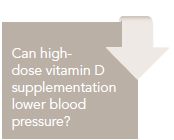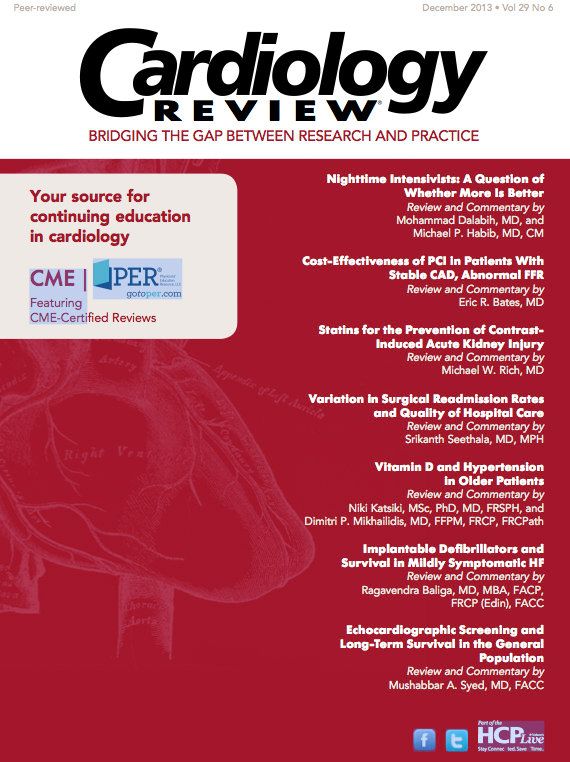Vitamin D and Hypertension in Older Patients

Niki Katsiki, MSc, PhD, MD, FRSPH,
and Dimitri P. Mikhailidis, BSc, MSc, MD,
FRSPH, FCP, FFPM, FRCP, FRCPath
Review
Witham MD, Price RJ, Struthers AD, et al. Cholecalciferol treatment to reduce blood pressure in older patients with isolated systolic hypertension: the Vit- DISH Randomized Controlled Trial [published online ahead of print August 12, 2013]. JAMA Intern Med.

Vitamin D deficiency has been linked to hypertension in observational studies, randomized trials, and meta-analyses,1,2 although the effect of vitamin D administration on blood pressure (BP) remains controversial.3 In this double-blind, placebo-controlled randomized trial [Vitamin D in Isolated Systolic Hypertension (VitDISH) study], Witham et al investigated whether high-dose cholecalciferol supplementation every 3 months for a year was effective in reducing BP in older (≥70 years) patients with isolated hypertension.4 Apart from BP, several markers were also recorded including lipids, high-sensitivity C-reactive protein (hsCRP), insulin resistance, flow-mediated dilatation, carotid-radial pulse wave velocity, 24-h BP, exercise capacity, and frequency of falls.
Study Details
Witham et al conducted a parallel-group, double-blind, placebo-controlled randomized trial—the VitDISH study—to evaluate the impact of cholecalciferol administration on isolated systolic hypertension. Eligible participants were of white ethnicity and aged ≥70 years with office systolic blood pressure (SBP) >140 mm Hg and 25-hydroxyvitamin D (25OHD) levels <30 ng/mL. Patients (mean age, 76.8 years; mean office BP, 163/78 mm Hg; mean baseline 25OHD, 18 ng/mL) were allocated to cholecalciferol (n = 80) or placebo (n = 79). Primary (ie, between-group difference in office SBP at 3 months) and secondary outcomes [24-h ambulatory BP measurement (ABPM), B-type natriuretic peptide (BNP), hsCRP, homeostasis model assessment of insulin resistance (HOMA-IR), brachial artery flow-mediated dilatation (FMD), carotid-radial pulse wave velocity (PWV), augmentation index (AIx), lipids, glucose, albumin, calcium, parathyroid hormone (PTH), exercise capacity, and frequency of falls] were recorded.
Cholecalciferol (100,000 U orally) was administered every 3 months for 1 year in the intervention group, leading to a 7-ng/mL rise in 25OHD levels at 12 months. In the placebo group, a small rise (3 ng/mL) in 25OHD concentrations was seen at 6 months.
No differences were observed in SBP between the 2 groups at 3 months. Mean decrease in office SBP at 3 months was 2.7 mm Hg in the intervention group and 1.4 mm Hg in the placebo group; the between-group difference was -0.7 mm Hg (95% confidence interval [CI], —5.2 to 3.8 mm Hg; P = NS) after adjusting for covariates and -0.9 mm Hg (95% CI, —5.3 to 3.5 mm Hg; P = NS) after adjusting for season of recruitment. Antihypertensive treatment remained unchanged in both groups at 3 months. Similarly, 24-h ABPM and office BP did not differ between groups during the study.
With regard to other secondary outcomes, PTH levels showed a small but significant fall (3.8 pg/mL) in the intervention group. The between-group difference in exercise capacity (6-min walk) compared with baseline was 16 m (95% CI, 2 - 31 m; P = .03) at 6 months and 12 m (95% CI, —4 to 28 m; P = NS) at 12 months, thus not reaching the minimum clinically important 20 m. Fewer falls were observed in the intervention group, but this difference was not significant. Adverse events were few and similar in both study groups.
Based on the lack of a significant impact on BP and other vascular markers, the authors propose that there is no effect of vitamin D on BP, especially in this patient population. However, it should be noted that almost half of the participants had a mean daytime SBP <135 mm Hg. Furthermore, mean calcium intake was high (>1 g/d) and vitamin D may have less to offer in such patients. The authors suggest that longer duration of administration, daily dosing, and earlier initiation of therapy may be required to achieve BP reductions. Additionally, the authors conclude that high-dose intermittent vitamin D supplementation should not be used for the treatment of isolated systolic hypertension in the elderly.
CommentaryMuch More to Vitamin D Than Just Hypertension
There is evidence supporting a link between vitamin D deficiency and hypertension,1 although the effect of vitamin D supplementation on BP remains controversial.3 In the VitDISH study, Witham et al4 reported no beneficial effects of intermittent cholecalciferol supplementation on BP and other cardiometabolic markers in older patients with isolated systolic hypertension. This is the first study to investigate the effects of vitamin D administration in such patients. However, the number of the participants in the VitDISH study is relatively small (n = 159), as was the rise in 25OHD. Also, Witham et al did not comment on dipping and non-dipping. In this context, others5 reported that hypertensive dippers had higher 25OHD levels than non-dippers (21.9 ± 7.4 vs 12.8 ± 5.9 ng/mL, P = .001).
The evaluation of target-organ damage is important in hypertensive studies. Low vitamin D levels have been associated with renal dysfunction in the general population6 and diabetic nephropathy in diabetics.7 Furthermore, conventional doses (800 IU) of cholecalciferol led to a significant reduction in microalbuminuria in patients with diabetic nephropathy.8 Therefore, microalbuminuria could have been recorded in the VitDISH study, although the number of patients would probably have been very small. Similarly, vitamin D deficiency has been linked to early age-related macular degeneration9 and diabetic retinopathy.10 One study also investigated the association between vitamin D and left ventricular mass, but reported no significant relationship.11
Apart from hypertension, serum 25OHD levels were found to be inversely associated with the risk of type 2 diabetes mellitus (T2DM).12 In the VitDISH study,4 14% of the total population had diabetes. In this context, 1,25OHD levels were inversely related to the severity of diabetic nephropathy.7 Furthermore, 25OHD deficiency was linked to diabetic foot infections,13 diabetic retinopathy,10 and diabetic peripheral neuropathy.14 A link between vitamin D insufficiency and elevated levels of serum uric acid (SUA) have also been reported in T2DM patients15 and postmenopausal women.16 Whether vitamin D supplementation can improve diabetic complications remains to be elucidated.
Vitamin D deficiency has been related to increased risk of developing metabolic syndrome (MetS).17-19 MetS, a cluster of central obesity, dyslipidemia, hypertension, and insulin resistance, is characterized by increased cardiovascular disease risk.17 Low 25OHD dietary intake was linked to a high MetS prevalence in the National Health and Nutrition Examination Surveys (NHANES) 2003-2006.20 Similarly, in the Coronary Artery Risk Development in Young Adults study,21 vitamin D intake from both food and supplements was inversely associated with MetS development over 20 years of follow-up in both black and white young individuals. In another study, MetS patients were shown to have significantly lower 25OHD levels (11.8 [0.6-48.3] ng/mL) compared with controls (17.2 [4.8-62.4] ng/mL; P = .027).22 However, data on the effects of vitamin D supplementation on MetS treatment are scarce. Therefore, it would be of interest to know what the prevalence of MetS in the VitDISH study was, and whether this changed following the administration of cholecalciferol.
Non-alcoholic fatty liver disease (NAFLD), the hepatic manifestation of MetS, is associated with increased cardiovascular risk.23,24 Vitamin D deficiency has been related to the presence and severity of NAFLD.25-28 Further research is required to investigate the role of vitamin D supplementation in NAFLD treatment.
Statins play an important role in the treatment of high-risk patients such as those with coronary heart disease, T2DM, CKD, MetS, and NAFLD.29-33 Previous studies have reported a link between vitamin D deficiency and statin-induced myalgia,34,35 although conflicting results exist.36,37 If indeed we can improve adherence to statin treatment with vitamin D supplements, then this should translate into better vascular disease prevention. It is also of interest that deficient 25OHD levels were associated with the decreased lipid-reducing capacity of atorvastatin38; however, vitamin D supplementation did not change atorvastatin effectiveness.39 Surprisingly, atorvastatin, simvastatin, and rosuvastatin have been reported to increase vitamin D levels.22,40-43 It should be noted that only half of the VitDISH study population were on a statin.4 However, there is no report on statin type, efficacy, and safety with regard to cholecalciferol administration.
In conclusion, Witham et al4 reported that high-dose cholecalciferol supplementation every 3 months for a year was ineffective in reducing BP in older (≥70 years) patients with isolated hypertension; several other cardiometabolic markers also remained unchanged. Further randomized clinical trials are needed to clarify the role of vitamin D supplementation in daily practice. Based on current knowledge, it seems that there is much more to vitamin D than just hypertension! Which actions will be confirmed and which refuted should make interesting future reading.
References
1. Kunutsor SK, Apekey TA, Steur M. Vitamin D and risk of future hypertension: meta-analysis of 283,537 participants. Eur J Epidemiol. 2013;28:205-221.
2. Burgaz A, Orsini N, Larsson SC, Wolk A. Blood 25-hydroxyvitamin D concentration and hypertension: a meta-analysis. J Hypertens. 2011;29:636-645.
3. Tamez H, Kalim S, Thadhani RI. Does vitamin D modulate blood pressure? Curr Opin Nephrol Hypertens. 2013;22:204-209.
4. Witham MD, Price RJ, Struthers AD, et al. Cholecalciferol treatment to reduce blood pressure in older patients with isolated systolic hypertension: the VitDISH Randomized Controlled Trial [published online ahead of print August 12,2013]. JAMA Intern Med.
5. Demir M, Günay T, Özmen G, Melek M. Relationship between vitamin D deficiency and nondipper hypertension. Clin Exp Hypertens. 2013;35:45-49.
6. Skaaby T, Husemoen LL, Pisinger C, et al. Vitamin D status and 5-year changes in urine albumin creatinine ratio and parathyroid hormone in a general population. Endocrine. 2013;44:473-480.
7. Yokoyama K, Nakashima A, Urashima M, et al. Interactions between serum vitamin D levels and vitamin D receptor gene FokI polymorphisms for renal function in patients with type 2 diabetes. PLoS One. 2012;7:e51171.
8. Huang Y, Yu H, Lu J, et al. Oral supplementation with cholecalciferol 800 IU ameliorates albuminuria in Chinese type 2 diabetic patients with nephropathy. PLoS One. 2012;7:e50510.
9. Millen AE, Voland R, Sondel Saet al; CAREDS Study Group. Vitamin D status and early age-related macular degeneration in postmenopausal women. Arch Ophthalmol. 2011;129:481-489.
10. Payne JF, Ray R, Watson DG, et al. Vitamin D insufficiency in diabetic retinopathy. Endocr Pract. 2012;18:185-193.
11. van Ballegooijen AJ, Visser M, Kestenbaum B, et al. Relation of vitamin D and parathyroid hormone to cardiac biomarkers and to left ventricular mass (from the Cardiovascular Health Study). Am J Cardiol. 2013;111:418-424.
12. Song Y, Wang L, Pittas AG, et al. Blood 25-hydroxy vitamin D levels and incident type 2 diabetes: a meta-analysis of prospective studies. Diabetes Care. 2013;36:1422-1428.
13. Tiwari S, Pratyush DD, Gupta B, et al. Prevalence and severity of vitamin D deficiency in patients with diabetic foot infection. Br J Nutr. 2013;109:99-102.
14. Shehab D, Al-Jarallah K, Mojiminiyi OA, Al Mohamedy H, Abdella NA. Does Vitamin D deficiency play a role in peripheral neuropathy in Type 2 diabetes? Diabet Med. 2012;29:43-49.
15. Yilmaz H, Kaya M, Sahin M, Delibasi T. Is vitamin D status a predictor glycaemic regulation and cardiac complication in type 2 diabetes mellitus patients? Diabetes Metab Syndr. 2012;6:28-31.
16. Peng H, Li H, Li C, Chao X, Zhang Q, Zhang Y. Association between vitamin D insufficiency and elevated serum uric acid among middle-aged and elderly Chinese Han women. PLoS One. 2013;8:e61159.
17. Katsiki N, Athyros VG, Karagiannis A, Mikhailidis DP. Characteristics other than the diagnostic criteria associated with metabolic syndrome: an overview [published ahead of print April 25, 2013]. Curr Vasc Pharmacol.
18. Khan H, Kunutsor S, Franco OH, Chowdhury R. Vitamin D, type 2 diabetes and other metabolic outcomes: a systematic review and meta-analysis of prospective studies. Proc Nutr Soc. 2013;72:89-97.
19. Florentin M, Elisaf MS, Mikhailidis DP, Liberopoulos EN. Vitamin D and metabolic syndrome: is there a link? Curr Pharm Des. 2010;16:3417- 3434.
20. Maki KC, Fulgoni VL 3rd, Keast DR, Rains TM, Park KM, Rubin MR. Vitamin D intake and status are associated with lower prevalence of metabolic syndrome in U.S. adults: National Health and Nutrition Examination Surveys 2003-2006. Metab Syndr Relat Disord. 2012;10:363-372.
21. Fung GJ, Steffen LM, Zhou X, et al. Vitamin D intake is inversely related to risk of developing metabolic syndrome in African American and white men and women over 20 years: the Coronary Artery Risk Development in Young Adults study. Am J Clin Nutr. 2012;96:24-29.
22. Makariou S, Liberopoulos E, Florentin M, et al. The relationship of vitamin D with non-traditional risk factors for cardiovascular disease in subjects with metabolic syndrome. Arch Med Sci. 2012; 8:437-443.
23. Athyros VG, Katsiki N, Karagiannis A. Nonalcoholic fatty liver disease and severity of cardiovascular disease manifestations. Angiology. 2013;64:572-575.
24. Katsiki N, Athyros VG, Karagiannis A, Mikhailidis DP. Hyperuricaemia and non-alcoholic fatty liver disease (NAFLD): a relationship with implications for vascular risk? Curr Vasc Pharmacol. 2011;9:698-705.
25. Seo JA, Eun CR, Cho H, et al. Low vitamin D status is associated with nonalcoholic fatty liver disease independent of visceral obesity in Korean adults. PLoS One. 2013;8:e75197.
26. Dasarathy J, Periyalwar P, Allampati S, et al. Hypovitaminosis D is associated with increased whole body fat mass and greater severity of non-alcoholic fatty liver disease [published online ahead of print September 5, 2013]. Liver Int. doi:10.1111/liv.12312.
27. Eliades M, Spyrou E, Agrawal N, et al. Meta-analysis: vitamin D and non-alcoholic fatty liver disease. Aliment Pharmacol Ther. 2013;38:246- 254.
28. Kwok RM, Torres DM, Harrison SA. Vitamin D and nonalcoholic fatty liver disease (NAFLD): is it more than just an association? Hepatology. 2013;58:1166-1174.
29. Athyros VG, Ganotakis E, Kolovou GD, et al; Assessing The Treatment Effect in Metabolic Syndrome Without Perceptible Diabetes (ATTEMPT) Collaborative. Assessing the treatment effect in metabolic syndrome without perceptible diabetes (ATTEMPT): a prospective-randomized study in middle aged men and women. Curr Vasc Pharmacol. 2011;9:647-657.
30. Athyros VG, Karagiannis A, Katsiki N, Mikhailidis DP. Statins in patients with renal dysfunction. Am J Cardiol. 2012;109:1537.
31. Athyros VG, Katsiki N, Karagiannis A, Mikhailidis DP. Are statins “IDEAL” for non-alcoholic fatty liver disease? [published online ahead of print October 28, 2013]. Curr Med Res Opin.
32. Athyros VG, Papageorgiou AA, Mercouris BR, et al. Treatment with atorvastatin to the National Cholesterol Educational Program goal versus “usual” care in secondary coronary heart disease prevention: the GREek Atorvastatin and Coronary-heart-disease Evaluation (GREACE) study. Curr Med Res Opin. 2002;18:220-228.
33. Katsiki N, Athyros VG, Karagiannis A, Mikhailidis DP. The role of statins in the treatment of type 2 diabetes mellitus: an update [published online ahead of pint September 12, 2013]. Curr Pharm Des.
34. Glueck CJ, Budhani SB, Masineni SS, et al. Vitamin D deficiency, myositis-myalgia, and reversible statin intolerance. Curr Med Res Opin. 2011;27:1683-1690.
35. Katsiki N, Athyros VG, Karagiannis A, Mikhailidis DP. Vitamin D deficiency, statin-related myopathy and other links with vascular risk. Curr Med Res Opin. 2011;27:1691-1692.
36. Kurnik D, Hochman I, Vesterman-Landes J, et al. Muscle pain and serum creatine kinase are not associated with low serum 25(OH) vitamin D levels in patients receiving statins. Clin Endocrinol (Oxf). 2012;77:36-41.
37. Riphagen IJ, van der Veer E, Muskiet FA, DeJongste MJ. Myopathy during statin therapy in the daily practice of an outpatient cardiology clinic: prevalence, predictors and relation with vitamin D. Curr Med Res Opin. 2012;28:1247-1252.
38. Pérez-Castrillón JL, Abad Manteca L, Vega G, Del Pino Montes J, de Luis D, Duenas Laita A. Vitamin D levels and lipid response to atorvastatin. Int J Endocrinol. 2010;2010:320-721.
39. Bittner V, Wenger NK, Waters DD, DeMicco DA, Messig M, LaRosa JC. Vitamin D levels do not predict cardiovascular events in statin-treated patients with stable coronary disease. Am Heart J. 2012;164:387-393.
40. Robien K, Oppeneer SJ, Kelly JA, Hamilton-Reeves JM. Drug-vitamin D interactions: a systematic review of the literature. Nutr Clin Pract. 2013;28:194-208.
41. Liberopoulos EN, Makariou SE, Moutzouri E, Kostapanos MS, Challa A, Elisaf M. Effect of simvastatin/ezetimibe 10/10 mg versus simvastatin 40 mg on serum vitamin D levels. J Cardiovasc Pharmacol Ther. 2013;18:229-233.
42. Makariou SE, Liberopoulos EN, Agouridis AP, Challa A, Elisaf M. Effect of rosuvastatin monotherapy and in combination with fenofibrate or omega-3 fatty acids on serum vitamin D levels. J Cardiovasc Pharmacol Ther. 2012;17:382-386.
43. Ertugrul DT, Yavuz B, Cil H, et al. STATIN-D Study: Comparison of the influences of rosuvastatin and fluvastatin treatment on the levels of 25 hydroxyvitamin D. Cardiovasc Ther. 2011;29:146-152.
About the Author
Niki Katsiki, MSC, PhD, MD, FRSPH, is a specialist in internal medicine and a researcher at the Medical School, Aristotle University of Thessaloniki, Thessaloniki, Greece. Her PhD is based on obesity-related peptides in diabetic patients. Dr. Katsiki’s clinical and research interests involve cardiovascular disease prevention and treatment. She has participated in obesity, lipid, diabetes, peripheral artery disease, and smoking cessation outpatient clinics with a special focus on dyslipidemias. Dr. Katsiki was an Honorary Clinical Research Fellow at the Department of Clinical Biochemistry (Academic Head, DP Mikhailidis), Royal Free Hospital campus, University College London Medical School, University College London (UCL), UK. She is also a SCOPE member of the International Association for the Study of Obesity. Dr. Katsiki serves as a reviewer for several cardiovascular journals and is the Editorial Manager of Angiology and Section Editor of Archives of Medical Science. She was assisted in the writing of this article by Dimitri P. Mikhailidis, BSc, MSc, MD, FRSPH, FCP, FFPM, FRCP, FRCPath, Academic Head of the Department of Clinical Biochemistry (Vascular Disease Prevention Clinics), and Department of Surgery, Royal Free Campus, University College London Medical School, UCL, London, UK. He is Editor-in-Chief of several journals including Current Medical Research and Opinion, Current Vascular Pharmacology, and Expert Opinion on Pharmacotherapy.
